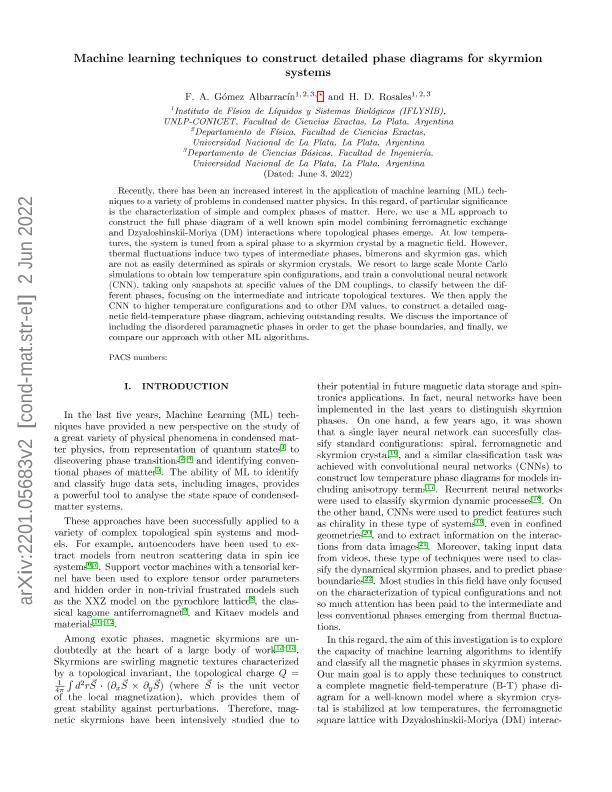Mostrar el registro sencillo del ítem
dc.contributor.author
Gómez Albarracín, Flavia Alejandra

dc.contributor.author
Rosales, Héctor Diego

dc.date.available
2023-09-22T16:35:20Z
dc.date.issued
2022-05
dc.identifier.citation
Gómez Albarracín, Flavia Alejandra; Rosales, Héctor Diego; Machine learning techniques to construct detailed phase diagrams for skyrmion systems; American Physical Society; Physical Review B: Condensed Matter and Materials Physics; 105; 21; 5-2022; 1-10
dc.identifier.issn
1098-0121
dc.identifier.uri
http://hdl.handle.net/11336/212735
dc.description.abstract
Recently, there has been an increased interest in the application of machine learning (ML) techniques to a variety of problems in condensed-matter physics. In this regard, of particular significance is the characterization of simple and complex phases of matter. Here, we use a ML approach to construct the full phase diagram of a well-known spin model combining ferromagnetic exchange and Dzyaloshinskii-Moriya (DM) interactions where topological phases emerge. At low temperatures, the system is tuned from a spiral phase to a skyrmion crystal by a magnetic field. However, thermal fluctuations induce two types of intermediate phases, bimerons and skyrmion gas, which are not as easily determined as spirals or skyrmion crystals. We resort to large-scale Monte Carlo simulations to obtain low-temperature spin configurations and train a convolutional neural network (CNN), taking only snapshots at specific values of the DM couplings, to classify between the different phases, focusing on the intermediate and intricate topological textures. We then apply the CNN to higher-temperature configurations and to other DM values to construct a detailed magnetic-field-temperature phase diagram, achieving outstanding results. We discuss the importance of including the disordered paramagnetic phases in order to get the phase boundaries, and, finally, we compare our approach with other ML algorithms.
dc.format
application/pdf
dc.language.iso
eng
dc.publisher
American Physical Society

dc.rights
info:eu-repo/semantics/openAccess
dc.rights.uri
https://creativecommons.org/licenses/by-nc-sa/2.5/ar/
dc.subject
SKYRMIONS
dc.subject
MACHINE LEARNING
dc.subject
TOPOLOGY
dc.subject
MONTE CARLO
dc.subject.classification
Física de los Materiales Condensados

dc.subject.classification
Ciencias Físicas

dc.subject.classification
CIENCIAS NATURALES Y EXACTAS

dc.title
Machine learning techniques to construct detailed phase diagrams for skyrmion systems
dc.type
info:eu-repo/semantics/article
dc.type
info:ar-repo/semantics/artículo
dc.type
info:eu-repo/semantics/publishedVersion
dc.date.updated
2023-06-29T10:25:58Z
dc.identifier.eissn
2469-9969
dc.journal.volume
105
dc.journal.number
21
dc.journal.pagination
1-10
dc.journal.pais
Estados Unidos

dc.journal.ciudad
New York
dc.description.fil
Fil: Gómez Albarracín, Flavia Alejandra. Consejo Nacional de Investigaciones Científicas y Técnicas. Centro Científico Tecnológico Conicet - La Plata. Instituto de Física de Líquidos y Sistemas Biológicos. Universidad Nacional de La Plata. Facultad de Ciencias Exactas. Instituto de Física de Líquidos y Sistemas Biológicos; Argentina. Universidad Nacional de La Plata. Facultad de Ingeniería. Departamento de Ciencias Básicas; Argentina
dc.description.fil
Fil: Rosales, Héctor Diego. Consejo Nacional de Investigaciones Científicas y Técnicas. Centro Científico Tecnológico Conicet - La Plata. Instituto de Física de Líquidos y Sistemas Biológicos. Universidad Nacional de La Plata. Facultad de Ciencias Exactas. Instituto de Física de Líquidos y Sistemas Biológicos; Argentina. Universidad Nacional de La Plata. Facultad de Ingeniería. Departamento de Ciencias Básicas; Argentina
dc.journal.title
Physical Review B: Condensed Matter and Materials Physics

dc.relation.alternativeid
info:eu-repo/semantics/altIdentifier/doi/https://doi.org/10.1103/PhysRevB.105.214423
Archivos asociados
